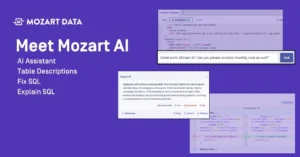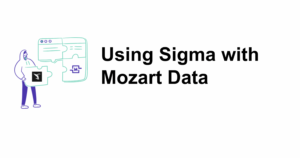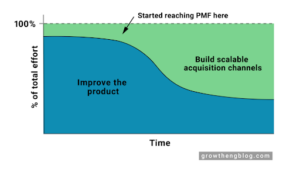Braze — a powerful tool and growing data challenge
Braze’s customer engagement platform handles massive data to deliver personalized marketing campaigns across various channels. Braze processed over 9 trillion consumer-generated data points in the last fiscal year alone and sent over 1.5 trillion messages to approximately 3.7 billion monthly active users.
Braze’s users want to approach sophisticated customer engagement challenges with data created by Braze and that they have access to from other tools, like payment solutions, ad platforms, CRMs, production and inventory databases, and more. Activating or “operationalizing” all of this data requires additional data tools.
Braze partnered with Snowflake, a cloud-based data warehouse, to support their customers’ data management needs.
Snowflake data warehouse for Braze
Snowflake offers a cloud data platform centered on a cloud data warehouse. You can take a deeper dive into data warehouses and Snowflake use cases here, but for now, a data warehouse allows users to centralize their data for analysis. There are a few key advantages to data centralization for tasks like automating reporting in dashboards and better managing historical data but in the context of Braze, the most notable advantage is breaking down data siloes so that all your data has the chance to work together.
Breaking down data siloes with a data warehouse
Data isn’t particularly useful without context; other data sources provide that context in most business cases.
Example: a SaaS company wants to understand their happiest customers so they can keep them happy and find more like them.
What’s the best way to identify these customers?
They likely have product usage data that shows which users are taking which actions, but do more actions mean happier customers? Is there a sweet spot? They probably need to pair usage data with subscription data in tools like Salesforce or a payments solution to see which customers spend money and stick around for a long enough time to see value in the SaaS tool.
The SaaS company may have found happy customers now, but the initial questions were on retention and sourcing new customers. Now, they need to look at customer segment data (often found in a tool like Braze!) and other marketing and sales data to understand what makes these customers similar, where they were found, what their journey looked like, etc.
This is exceedingly difficult if you can’t combine data. A centralized data warehouse immediately solves this problem.
In the context of Braze, a Snowflake data warehouse allows users to bring together the data they need to run more effective campaigns and influence their audience.
Why Snowflake and Braze are partnering
Snowflake was chosen as a Braze Alloys technology partner in data and analytics because it met Braze’s requirements for scalability, efficient handling of semi-structured data, and providing connections for developer teams to access data through preferred tools.
By leveraging Snowflake’s capabilities, Braze can effectively manage and analyze large amounts of data, enabling them to deliver personalized marketing campaigns and engage with their consumers throughout the customer journey.
Pairing Braze and Snowflake in practice
If you’re a Braze user considering setting up a Snowflake data warehouse, the goal is to maximize the value of your customer and campaign data. But how does this work in practice?
Once you set up a Snowflake data warehouse, you can start sending data to the warehouse for centralization and analysis. This can include data from Braze, as well as ad platforms, CRMs, payment solutions, product and inventory databases, etc. Whatever data matters to your operation, you want to move that to Snowflake, especially if you’re struggling to analyze it efficiently now or want to combine it with data from another source.
The first step is understanding how to move data from your various tools to your Snowflake data warehouse. For Braze data, Snowflake’s Secure Data Sharing may be sufficient. However, you’ll likely need an additional tool like Fivetran that manages data extraction and loading for the rest of the data you need to get into your warehouse.
The process of moving data to the warehouse often includes “cleaning” the data to remove duplicate values, standardize formats for things like dates, etc., This ensures users are confident the data is reliable. Cleaning is part of a larger process called “data transformation”, essentially the organization of data for analysis.
Consider the examples above where multiple data sources are required to answer a question; data transformation would often be used to combine that data, map accounts from one source to another, etc. This work is a core component of most data strategies and much of it must take place once the data is in the warehouse. This requires data transformation tooling.
Once data is organized, it’s much easier to analyze. But what about sending it back to Braze? Fortunately Braze has built features to enable this valuable work.
You can quickly send data from Snowflake to Braze with Cloud Data Ingestion, syncing user attributes, events, and purchases directly from Snowflake to use in Braze for personalization, segmentation, and campaign triggering
Overall, Snowflake data warehouse offers a powerful and efficient solution for integrating and analyzing data from Braz, enabling organizations to make data-driven decisions and enhance their marketing strategies — if the complete collection of data tools needed to work with data is in place.
The challenges of utilizing Snowflake
Successful Braze users are data-savvy problem solvers. However, few have experience setting up and maintaining heavyweight data solutions like Snowflake’s data warehouse and the other tools needed to make the most of data. This raises the risk of Snowflake becoming a complex, difficult-to-use solution for Braze with rapidly rising costs.
To properly manage these tools you need one of the following:
- A data engineering team
- The services of a data consultancy
- An out-of-of-the-box platform like Mozart Data
Most Braze users aren’t in a position to build an engineering team, but even without such limitations, this is the most expensive option as it involves headcount and paying for the same set of tools.
A data consultancy can be a good option for some teams, especially if there are other pressing data projects at the organization and you’re worried about the bandwidth to prioritize and tackle all of them. These consultancies will still need to set up the rest of the data infrastructure, so the costs will be higher than an out-of-the-box option that manages tools and implementation for you. But, there are scenarios where consultants can make a great deal of sense, and we’re always happy to chat about where and how technology and services come together if you need help.
The last option is an out-of-the-box platform like Mozart Data. This is the most cost-effective option with the fastest implementation timeline, so you can get to value faster.
We’re a Braze Alloys partner because our tools and data analyst support make Snowflake data warehouses and other data infrastructure more accessible to any team, whether or not they have employees with “data” in their title.
With Mozart, you can set up a Snowflake data warehouse and sync your data in hours, at a lower cost than going directly to Snowflake because we buy credits in bulk and pass those discounts along to our customers. We include Fivetran (with another bulk discount), data transformation tools, and more, so you don’t have to buy these separately and manage more integrations.
Beyond the tools, our in-house data analysts can help you take the steps needed to power Braze with any valuable data from anywhere in your organization, so you’re never leaving insights on the table when you engage with your audiences.
Interested in learning more about how Snowflake and Braze can work together? Just schedule a demo with our team.


